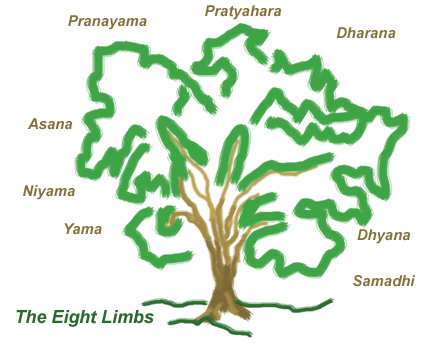Shortly after the Yoga Sutra explains the three stages of Kriya Yoga, a more extensive practice is given. This is the famous eight limbs of yoga, which has come to be called “the ashtanga.” [1]
The eight limbs are:
- Yama
- Niyama
- Asana
- Pranayama
- Pratyahara
- Dharana
- Dhyana
- Samadhi
There was a fondness in the philosophies of this era to create easy to remember lists: the five vrittis, the five kleshas, and the eight limbs. The Buddha also employed this technique, as we will discover.

The ashtanga begins with the yamas and niyamas, which are the ethical core of yoga. These are analogous to the Western Ten Commandments, with one important difference. Joseph Campbell points out that, in the West, the Ten Commandments are a bargain with God; if we conduct ourselves in accordance to these ten rules, we shall be rewarded in heaven. Religious people in the West strive and struggle to live according to these rules. Obviously we do not always succeed, and our failings can cause considerable grief and guilt.
In the Eastern world, Campbell suggests, the ethical precepts of the yama and niyamas are ways that the spiritually advanced person acts. These precepts are not meant to be applied first, and then, once you master them, you are allowed to proceed with the other limbs of yoga. Rather, as you progress in your practice of yoga, you will find that your actions will become more and more ethical; more and more you will act in accordance to these precepts. With this understanding, we can strive to live ethically, but when we fail, we are not overcome with guilt or immobilized by grief.
The yamas are practices that govern our outward relationships. [2] There are five yamas:
- Ahimsa (non-harming)
- Satya (truthfulness)
- Asteya (non-stealing)
- Brahmacharya (living as God would live)
- Aprigraha (non-greediness)
All of these yamas can also be found in our relationship to our yoga practice:
| Ahimsa: | When we perform asanas, are we truly non-harming our body, or are we pushing too deep? |
| Satya: | Are we honestly watching what is arising, or are we telling tales to ourselves in order to con ourselves into going too far? |
| Asteya: | Are we stealing calmness from our breath? |
| Brahmacharya: | Are we performing the practice the way an enlightened master would perform? |
| Aprigraha: | Are we grasping after more than we really need right now? |
Following the yamas are the niyamas, which show up in our inward relationship with our self. Again there are five:
- Saucha (purity or cleanliness)
- Samtosha (contentment)
- Tapas (austerity)
- Svadhyaya (self-study)
- Ishvara-pranidhana (surrendering to a higher power)
Once again all five niyamas can be developed in our Yin Yoga practice. The Hatha Yoga texts suggest that, before beginning your practice, the student should bathe, evacuate the bowels, and ensure the room is clean and free from bugs. This is saucha. Without a pure, clean body, our practice will not bear fruit. Samtosha, or contentment, is also to be practiced. With contentment, there is no grasping, no attachment or aversion. The final three niyamas we have seen before. These are the three stages of Kriya Yoga. [3]
The limbs of asana and pranayama will be discussed later in our journey. The final four limbs of the ashtanga are purely mental practices. Pratyahara develops the ability to focus; it is the closing of the sense doors, and a shutting out of all distractions. Yin Yoga provides many opportunities to practice pratyahara. We go deeply inside and are cut off from the distractions of the outer world. From here, dharana is possible. Dharana is concentration. This can be concentration upon an object, a sound, or even a sensation. The breath is a favorite object for concentration during asana or pranayama practice.
Dhyana [4] is meditation: in the state of meditation the object of meditation and the subject doing the meditation begin to merge. There are no thoughts arising to interfere with the perception of the object and the object itself. However, total oneness has not yet been reached. That occurs in samadhi.
- — Ashta means eight and anga means limbs. Curiously, the Yoga Sutra does not mention this name, and some scholars feel that the ashtanga was added to the original sutra hundreds of years later, in much the same way that many religious texts in the West were edited and modified by copyists centuries later.
- — Many texts of yoga describe these yamas. Light on Life by Iyengar is recommended for students wanting to learn more. Also recommended is the The Heart of Yoga by T.K.V. Desikachar.
- — It is their repetition here that leads some scholars to believe that the ashtanga was added to the Yoga Sutra centuries after its original compilation.
- — The evolution of the word dhyana is interesting. When the practices of yoga filtered into China, the words went with them. In the fifth century, the Bodhidharma arrived in China, practicing a special kind of Buddhist dhyana. The Chinese called this practice ch’an. In the tenth century, Japanese monks returning to Japan after studying this new practice, called this practice Zen. Thus the Japanese word Zen is actually derived from Sanskrit dhyana: meditation.
(Next: Samadhi and Kaivalya )
